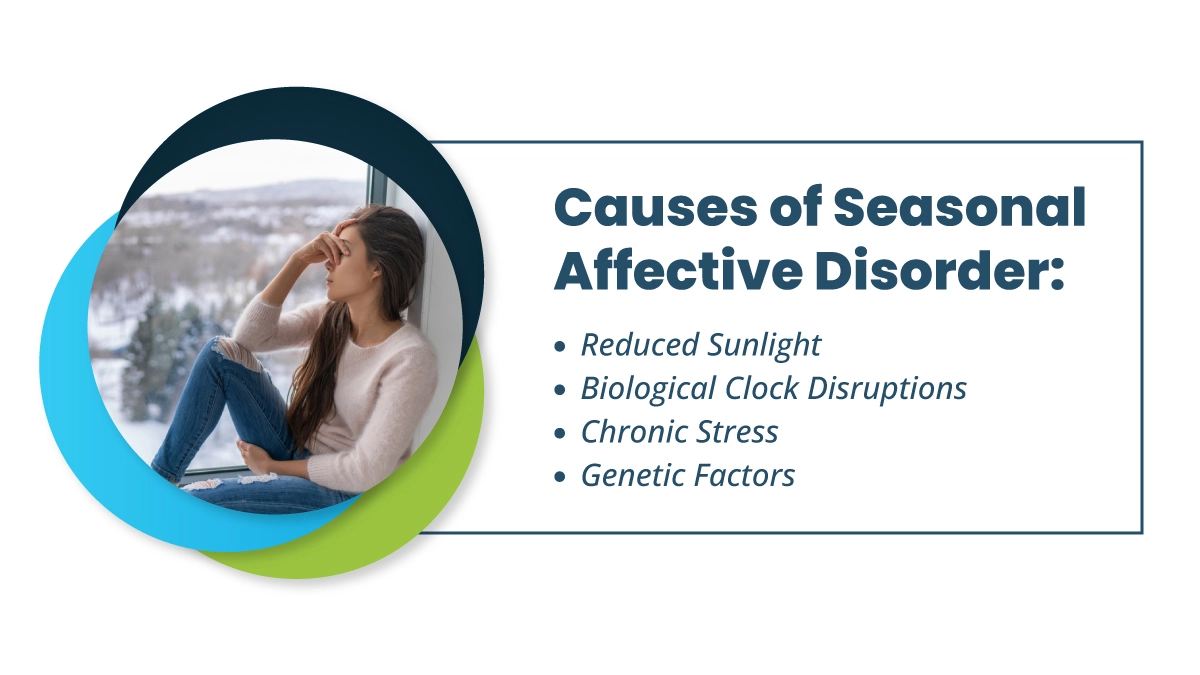Seasonal affective disorder (SAD) is a standard type of depression that occurs seasonally, typically during the fall and winter. It can affect anyone, but you may wonder if this condition has a familial connection.
This mood disorder is characterized by low energy, irritability, oversleeping, and a general sadness or hopelessness. In this article, we’ll explore the causes of seasonal affective disorder, how it impacts mental health and methods for managing and treating this condition.

Key Takeaways
SAD is a seasonal depression that most commonly occurs in fall and winter. Here is what you need to know:
- Common symptoms of seasonal affective disorder (SAD) are similar to those of major depressive disorder, including persistent sadness or hopelessness, changes in sleep patterns and appetite, and low energy levels.
- SAD is effectively managed using a combination of light therapy, cognitive behavioral therapy, and medication.
- Light therapy is considered an essential treatment option for recovery, which involves using a lightbox, among other treatments.
- SAD symptoms improve in summer but return in late spring and early fall.
The Haven Detox-New Jersey is an accredited facility that provides comprehensive addiction treatment and support. Contact us at (856) 565-3102 to color your mental health.
Prevalence of Seasonal Affective Disorder
Seasonal affective disorder, often called SAD, is a subtype of major depressive disorder. It manifests primarily during the autumn and winter seasons when daylight becomes scarcer. The state is characterized by recurring episodes of depression that coincide with specific seasons, usually resolving in spring or summer.
Seasonal Affective Disorder (SAD) is linked to reduced sunlight during certain seasons, leading to symptoms resembling major depression. It includes excessive melatonin production affecting sleep patterns. Light therapy, a standard treatment, involves exposure to artificial light sources. Consult a healthcare provider if you experience SAD symptoms.
The prevalence of SAD is important to gauge the scope of the issue. According to the National Institute of Mental Health (NIMH), nearly five percent of adults in the United States experience SAD, with symptoms recurring yearly.
It’s more common in northern regions where daylight is significantly reduced during winter, such as Alaska, where the prevalence can be as high as ten percent.
Causes of Seasonal Affective Disorder
The causes of seasonal affective disorder are multifaceted and interplay in a way that leads to its development. Let’s delve into the factors that contribute to the onset of SAD:
Reduced Sunlight
One of the primary culprits behind SAD is the reduced exposure to natural sunlight. Sunlight is pivotal in regulating our internal biological clock and mood.
During the darker months, the brain produces more melatonin, a hormone that handles sleep, in response to decreased sunlight. As a result, people with SAD experience disrupted sleep patterns, fatigue, and an overall decrease in mood.
Biological Clock Disruptions
Human bodies have an internal clock known as the circadian rhythm, which regulates diverse physiological processes, including sleep-wake cycles and mood. Reduced exposure to daylight during the winter months can disrupt this delicate balance. The result is often sadness, lethargy, and a general sense of disorientation in time.
Chronic Stress
Stress is a significant factor in the development and exacerbation of SAD. The pressures of daily life can intensify during the holiday season, leading to increased stress levels. Chronic stress can contribute to the symptoms of depression associated with SAD, amplifying the impact on mental health.
Genetic Factors
While the exact genetic factors contributing to SAD remain a subject of ongoing research, evidence suggests a hereditary component. If SAD runs in your family, you may be at a higher risk of developing the disorder. However, having a genetic predisposition does not ensure that you will experience SAD. The other environmental and lifestyle factors also play a role in its development.
It’s essential to remember that these causes are interrelated. They can collectively contribute to the onset of seasonal affective disorder.
Substantial Effects on Mental Health
The marks of seasonal affective disorder on mental health can profoundly and significantly impact an individual’s overall well-being. Common symptoms of SAD include:
Depression: Individuals with SAD often experience persistent sadness, grief, and a loss of interest in activities they once enjoyed.
Fatigue: The lack of sunlight can lead to increased melatonin, resulting in feelings of excessive fatigue and tiredness.
Changes in Sleep Patterns: SAD can disrupt sleep, leading to oversleeping or insomnia.
Weight Gain: Increased appetite, particularly for carbohydrates, can result in unwanted weight gain during winter.
Difficulty Concentrating: Concentration and focus may become compromised, making it challenging to perform daily tasks efficiently.
Social Withdrawal: Many individuals with SAD tend to isolate themselves from social activities and relationships.
The cumulative effect of these symptoms can significantly impact an individual’s quality of life, affecting their work, relationships, and overall happiness.
Managing and Treating Seasonal Affective Disorder
Less sunlight can trigger seasonal affective disorder (SAD). For example, a chemical change in the brain is linked to SAD symptoms due to reduced sunlight exposure.
Thankfully, there are various strategies for managing and treating seasonal affective disorder. Here are some approaches that can help alleviate the symptoms of SAD:
Light Therapy
Light therapy, or phototherapy, involves exposure to bright light that mimics natural sunlight. This therapy helps regulate the circadian rhythm and improve mood. Lightboxes emitting 10,000 lux of cool-white fluorescent light are commonly used. It’s crucial to follow the recommendations of a healthcare professional when using light therapy.
Medication
For severe cases of SAD, doctors may prescribe antidepressant medications to alleviate symptoms. These medicines can help regulate mood and reduce the impact of depression.
Lifestyle Changes
Making positive modifications to your lifestyle can also help manage SAD. Regular physical activity, a proportional diet, and stress control through relaxation techniques can improve mental well-being.
Psychotherapy
Counseling through cognitive behavioral therapy (CBT) can help people pinpoint and revise negative thought habits and behaviors associated with SAD. It can be a valuable component of treatment.
Support System
A support system, such as friends, family, or support groups, can provide emotional assistance during difficult times. Sharing incidents and feelings with others who understand can be incredibly beneficial.
If you or someone you know is experiencing symptoms of SAD, it’s essential to seek professional help and explore treatment options to regain control over your well-being.
Frequently Asked Questions (FAQ)
What is the primary cause of SAD?
The primary cause of seasonal affective disorder (SAD), also called winter depression or seasonal depression, is the seasonal changes in light exposure. SAD typically occurs during late fall and early winter, triggered by shorter days and reduced sunlight. This lack of daylight can disrupt the body’s internal clock and affect the production of vital sleep-related hormones, such as melatonin.
For some, SAD is also associated with a drop in serotonin levels, a neurotransmitter that regulates mood. While the accurate cause is not fully understood, researchers have noted a potential link between SAD and bipolar disorder. Treatment options often include antidepressant medicines, such as selective serotonin reuptake inhibitors (SSRIs), to alleviate the symptoms of this mental health condition.
Can you stop seasonal affective disorder?
Seasonal affective disorder (SAD) can be managed and alleviated, although entirely stopping it can be challenging. During the summer months, when there’s more sunlight, the symptoms of SAD, often referred to as winter blues, tend to improve. Early summer brings relief, but as late spring turns into fall, the condition may return with reduced sunlight.
The main treatment options include light therapy using a light box, which helps compensate for the lack of natural light and cognitive behavioral or interpersonal therapy. Medications, such as SSRIs, can also be prescribed.
Healthcare providers may recommend blood tests to check melatonin and other factors contributing to SAD. While it may not be completely preventable, managing SAD’s depressive symptoms often involves a combination of these strategies.
Prioritize Your Mental Health With The Haven Detox-New Jersey
We understand seasonal affective disorder (SAD) can profoundly impact mental health. With The Haven Detox-New Jersey, we provide you with a haven for recovery.
The safe and nurturing environment of the residential program helps you rebuild your mental health. Our medical team is dedicated to addressing mental health issues and provides detox programs for those struggling with addiction.
Also, with our innovative IV therapy, we help you replenish the essential vitamins lost during the struggle and treatment. Don’t let SAD define your life.
Contact us at (856) 565-3102, and rediscover your joy and vitality today.

 (856) 565-3102
(856) 565-3102




 21 December 2023
21 December 2023 

